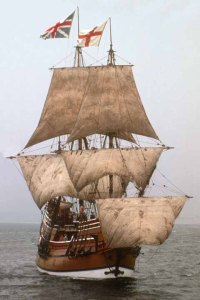Hopkins
Editor’s Note: My son David is guest-blogging with another post about the history of the Smith family. This post stems from research done for a previous post on the Boynton family.

The lineage of Amos Boynton‘s wife takes us through another important chapter of America history. The former Sarah Snow is a great-great-granddaughter of Constance Hopkins Snow, who came to America aboard the Mayflower with her family as a 14-year-old in 1620. Constance’s future husband Nicholas Snow came over just three years later on the Anne. They married in 1627 in Plymouth. Since Constance is my 10th great-grandmother, we’ll have to remember her for any future New York Times wedding announcements.
Constance, her younger brother Giles, and half-sister Demaris ended up on the Mayflower courtesy of their father, Stephen Hopkins, a figure of some historical impact. Not only was he one of 41 signatories to the Mayflower Compact, but he is now believed to be the only Mayflower passenger to have previously been to the New World. His adventures included surviving the shipwreck of the Sea Venture in Bermuda in 1609–and narrowly escaping a death sentence for mutiny–on his way to working in Jamestown 1610-14. News stories and accounts of the harrowing wreck, the mutiny, and the mysteries of Bermuda reached England and enchanted the country. This could have inspired Shakespeare to write his 1611 play The Tempest, a subplot of which involving a mutinous butler named Stephano may have been based on Stephen Hopkins. Just as historically, Stephen probably knew Pocahontas, who married John Rolfe, a tobacco entrepreneur and fellow Sea Venture traveler to Jamestown.
While Stephen was out exploring new worlds, his wife (and mother of three, including Constance), Mary Hopkins, died in England in 1613. Stephen returned from America to care for his family a year later upon learning of her death via a VERY slow mail system. He remarried in London in 1617 to Elizabeth Fisher. Elizabeth gave birth to a daughter, Demaris, prior to the Mayflower leaving England, AND TO ANOTHER CHILD ON THE MAYFLOWER ITSELF. They named the boy Oceanus. You can’t make this stuff up.

Upon arrival in Plymouth, Stephen was tapped by military advisor Myles Standish (good ol’ Kilometres Deboutish) as his main envoy with the locals based on his experience with Native Americans in Jamestown. As a result, Stephen was a key figure in establishing a mutually beneficial relationship with the natives. He later opened a tavern in Plymouth that acted as an important meeting center for the colonists. Despite his prominence, according to one account he wasn’t necessarily a model citizen: “Several times he was fined for serving drink on Sunday, for permitting servants to drink and play shuffle board at his place, and for allowing his friends to get drunk.” Seems to me like there are much worse crimes.
 Stephen and Elizabeth had five more kids in the New World, but only four of Stephen’s children would survive the harsh conditions in Plymouth, reach adulthood, and have children. They are the original “Boston Strong.” Their large families–Constance herself had 12 children–settled around Eastham and Orleans on Cape Cod for many generations. No wonder we felt so at home there when we vacationed in Eastham last summer.
Stephen and Elizabeth had five more kids in the New World, but only four of Stephen’s children would survive the harsh conditions in Plymouth, reach adulthood, and have children. They are the original “Boston Strong.” Their large families–Constance herself had 12 children–settled around Eastham and Orleans on Cape Cod for many generations. No wonder we felt so at home there when we vacationed in Eastham last summer.
 Wanna know who else descended from Stephen Hopkins? Sarah Palin. You betcha. Her lineage goes back through Constance’s brother Giles. Again, you can’t make this stuff up. In all, there are about 10 million Americans who can trace some portion of their lineage back to the Mayflower pilgrims. Approximately two million of those are related to Stephen Hopkins. His quite prolific descendants regularly churned out 8-12 children per family for many generations. That kind of rapid exponential growth increases the total population pretty rapidly. And that is Stephen Hopkins’s greatest legacy.
Wanna know who else descended from Stephen Hopkins? Sarah Palin. You betcha. Her lineage goes back through Constance’s brother Giles. Again, you can’t make this stuff up. In all, there are about 10 million Americans who can trace some portion of their lineage back to the Mayflower pilgrims. Approximately two million of those are related to Stephen Hopkins. His quite prolific descendants regularly churned out 8-12 children per family for many generations. That kind of rapid exponential growth increases the total population pretty rapidly. And that is Stephen Hopkins’s greatest legacy.
Leave a Reply